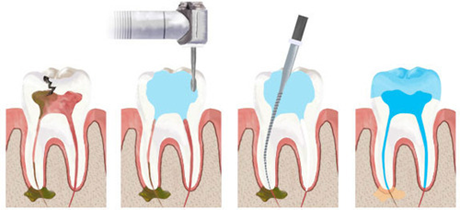Pulpectomy is a dental procedure where the whole dental pulp is removed, both the coronal and radicular part. This way the dentist removes all of the infected tissue and the tooth can be saved and not extracted. The root canals and pulp chamber are filled with special dental materials, and a dental filling is also placed. The tooth will stay in the mouth and will be able to perform all of its functions.
There are times when the tooth cannot be treated with a pulpotomy and the whole pulp has to be extracted. In these cases, dentists decide to perform a pulpectomy. In other words, they remove all caries and later also remove both the coronal and radicular pulp. This means that the tooth is not vital anymore. There is no connection with the surrounding tissue, blood vessels, and nerves. The tooth can still be saved and kept in the mouth. That’s why pulpectomy is such an important procedure. In a lot of patients, it’s already late to try saving the vitality, because inflammation and infection spread very fast in the pulpal cavity.
Uses:
It is mostly used to treat baby teeth that have to stay in the mouth for a certain time. A lot of dentists also refer to this procedure as a root canal. Unlike pulpotomy, where the damage has to be minimal, pulpectomy is used for a more extensive damage of the pulp. Baby teeth with secondary decay, constant pain, hypersensitivity to cold or hot, with a severe trauma, abscess, loss of bone, dental trauma, bad fillings and more. All of these factors can reach to the dental pulp and cause an inflammation and infection. Once that happens, the dentist has to act right away.
Treatment:
The procedure is performed under anesthesia to prevent discomfort and pain. If there was a dental abscess, the patient will have to get antibiotics one week before the procedure. The treatment includes removing all the decay and leaving a clean cavity. The following step includes removing the coronal and radicular pulp. For the radicular part, dentists use a number of special thing instruments so they could remove all the remaining tissue and debris. Once that’s done, dentists fill the roots and the crown with special materials. Pulpectomy helps save teeth in the mouth, and have them keep the space for the permanent teeth. The tooth can still help with biting, talking, mastication and more which is more than important. That is why pulpectomy is an extremely useful procedure that shows great success rates if performed properly.
The best way to prevent the use of this procedure is good oral hygiene. If the pulpectomy is not successful, dentists usually decide to extract the tooth. If it is crucial for the space to be filled, that can be done with special space maintainers.





